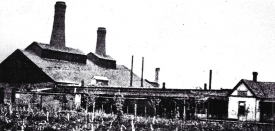
The factory grew rapidly and, in the summer of 1897, the factory was enlarged and several "day tanks" were added. In November 1898, the addition of a 60 ton melting furnace called a "continuous pot" was added.
The Indiana Tumbler & Goblet Company first pressed crystal glass, however, by late 1897 to early 1898, they were producing various transparent colors, including amber, teal blue, canary or vaseline, and emerald green. In 1898-1899, opaque white was being utilized and transparent cobalt blue shortly after that. In 1900, the glass chemist Jacob Rosenthal came to Greentown and perfected his opaque brown glass, and in 1901, this chocolate glass was a market sensation. An opaque green, now known as Nile Green, followed. Rosenthal's opalescent Golden Agate made its debut in early 1903, and a Rose Agate was being readied for productions when the Greentown plant was destroyed.
Because the glass industry in the United States was rapidly changing, the Indiana Tumbler & Goblet Company was absorbed into the National Glass Company, a newly formed combine which included 19 glass tableware factories in Pennsylvania, Maryland, West Virginia, Ohio, and Indiana. The purpose of the National Glass Company was to reduce competition among the member companies, effect cooperation in production, utilize economies of scale by purchasing raw materials in larger quantities, and regulate prices by controlling the output of glass.
On June 13, 1903, around noon, just after the Saturday morning glassworkers finished their turn and left the plant, the Indiana Tumbler & Goblet Works was destroyed by fire. Unfortunately the Greentown fire fighting equipment was not equipped to handle such a blaze and the inferno took the factory. Within days, the skilled glassworkers left Greentown to find other work. The residents of Greentown struggled to reopen the factory. Lawsuits were filed, investors were sought out, however, because of the financial constraints of the National Glass Company and because the natural gas fields had given the factory many past problems, the factory in Greentown was never rebuilt.
You can read a lot more information about the Indiana Tumbler and Goblet Company and the products produced there (now known as Greentown Glass) in the official publication of the National Greentown Glass Association, available on this site.
